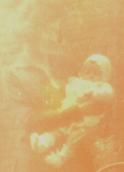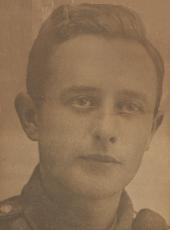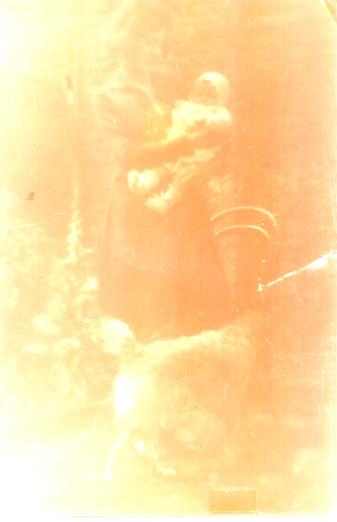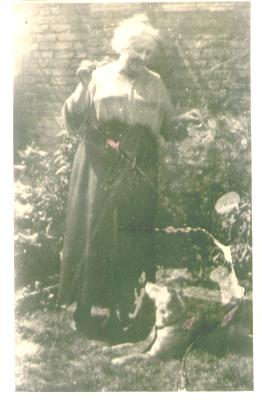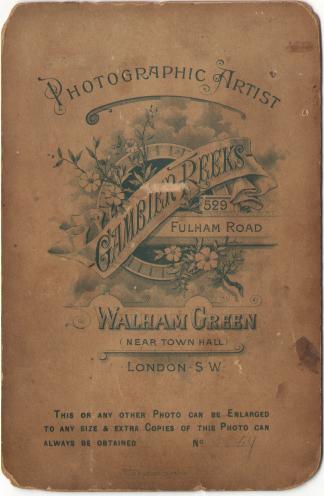Cosy Corners in Depression and War
Autobiography of Joan Martin [Mrs Joan Hughes]
The story of one person's nests
I began life at 59 May Street in West Kensington, London. This house was midway down the street, at one end of a block of terraced houses. There was a passageway down the side of our house. The back garden could be reached by a wooden door adjoining the house, where it faced the street. This wooden door was shut by means of a latch, but had no lock. There was a small front garden, in which there grew chrysanthemums and Michaelmas daisies.
59 May Street had been the family home since before 1908 (Electoral Register). In the census of 1911, Joan's grandfather, Frederick John Martin, was not at home (he may have been visiting relatives in Ireland) and her grandmother, Mary Theresa Martin (born Ennis) completed the form. She entered that four children had been born alive and three were still living. These were John (Joan's father) who was 13, Violet (Joan's Aunt Violet, who married Leonard Maurice Noble) and Alice Martin, aged 10. The children had all been born in the Sands End area of Fulham. (Possibly at 9 Britannia Road, north of the Gas works). Alice died from T.B, age 17, in the winter of 1918. Frederick John died, aged 71, in the late summer of 1929, when Joan was only one and a half. Mary Theresa died (aged 72) in the late summer of 1936 when Joan was eight years old. Joan's father, John May Martin, was born 8.5.1897 in Fulham. Sunday 31.3.1901/Monday 1.4.1901, aged three, he was living at 9 Britannia Road, Fulham, with both parents, sister and one week old unnamed baby, plus Mary A. Sanders, widow, a 35 year old "monthly nurse sick)". Another family shared the house. When John was about eight years old, Frederick John Martin took him for a father and son photograph at Gambier Reeks Photographers in Fulham Road. The family moved to 59 May Street soon after this. On Sunday 2.4.1911/Monday 3.4.1911, aged thirteen, he is living there with his mother and sisters (father absent) and Elizabeth Cook, a 41 year old visitor, born Wocester, who worked as a general servant. John was preparing for army service from the age of fifteen (1912. See below). He had a medical examination on 15.8.1916 when he declared his age as 19 years and three months. Trade or Occupation decorator. Height 5 feet 9.5. inches. Weight 124 lbs. Chest 31 to 34 inches (breathing in and out). Enlisted 10.1.1917. 59 May Street, Fulham recorded on his army records as his home address and Mary Martin, mother as his nearest relative. Religion Roman Catholic. Trade shown as Riveter in January 1917. He qualified as a Skilled Fitter on 24.10.1917 and was posted to France in November 1917. He was active in France and Flanders. From 23.8.1918 to 6.9.1918 he was on Leave to the UK via Calais. This may have been to visit his sister Alice in the TB Sanatorium. On demobilization at Dover, on 23.5.1919, he was transferred to the class Z Army reserve.
Picture taken by Gambier Reeks Photographers, 529 Fulham Road, Walham Green, London. On leave five days from France. Christmas? Received 191? - [Notes on plastic cover. Difficult to read.]. See May 1969 picture and picture of Gladys. John May Martin married Gladys Mary Ruthen in Fulham in the summer of of 1923. At this time she was working at the Harold Fink Memorial Hospital, 17 (Old) Park Lane, Mayfair. As she only had half a day for herself each week, her social life would have been restricted and it is possible that they met when he was working as a decorator for her employer. Their first child, John, died when he was two weeks old. Joan was born about two years later in 1928.
Joan's Aunt Violet, Violet Mary Martin, was born Fulham 4.1.1900.
She married
Leonard Maurice Noble (1881-1931), a widowed artist, in Fulham in the
summer of 1927 when she was 27 and he was about 46.
They lived (1929,1930,1931) at 1 St Oswalds Studios, West Brompton.
Their
daughter Rosie died as a baby.
Joan's cousin, Leonard F. Noble (1929-201?), was born in Fulham on
19.8.1929. Leonard Maurice Noble, his father,
died in St Georges Hospital, Hyde Park Corner on 24.11.1931 when Leonard F.
was only two years old and Joan was three. Probate London 19.12.1931 to
Violet Mary Noble widow. Effects £481.1s.1d
After her husbands death, Aunt Violet moved into 59 May Street with her
mother and Joan's parents. She then
took over a sweet shop and moved out with her mother (Mary
Martin), who looked after Leonard whilst Violet was working.
The addresses traced for Violet Mary Martin after May Street are 1934: 122
Estcourt Road with Mary Theresa, and Mrs Lily Gatcum -
1935: 184 Lillie Road SW6 with Mary Theresa and other people
1939: 85
Chesson Road, W14 with other people including Emma Shipway, widow, whose
family home this was [Leonard not listed. Evacuated to Devon]. This is
propabaly the address from which
the Noble pictures were removed in 1940. After this, Aunt Violet was in
hospital. By 1944 she had recovered and lived in a new council flat with
Leonard (aged 14), who had returned from Devon and was attending an Art
School.
1949:
11a Perham Road, London, W14, with Joan M. Martin (Leonard in
the Army). Violet M. Noble was still registered at 11 Perham Road in 1965.
Joan left her things at Aunt Violet's when she
went into Horton Hospital in 1965 and stayed with her again
when
she left the hospital.
Aunt Violet died aged 93 in Havering (Romford, where Leonard lived) in the
summer of 1993.
In 1928 the registered voters at 59 May Street were Frederick John
Martin, Mary Theresa Martin, John May Martin, and Gladys Mary Martin. [In
1928 the women were registered because they were over 30 and living in a
house occupied by their husband. In 1929 they were registered in their own
right, due to the 1928 Representation of the People Act].
|
|
Wartime and many subsequent moves means that I have preserved very few
family documents.
|
Another sepia photo shows me in a white party frock, obviously my best clothes, standing in front of a dining room chair. My aunt May told me it was taken when I was four years of age. Possibly by my grandfather. I do not remember him very well, but was told that he played the banjo. I have also got a painting by him, of a sweetshop, in Sheepcote Road, London, quite far from where we lived. He worked in the building trade, and probably knew all parts of London. I was told that he had "brittle legs" and during his life , broke a leg several times; when off work, owing to such an accident, he painted in water-colours, in order to occupy his time. He worked as foreman for an old -established firm, and presumably, as foreman, his job was safe.
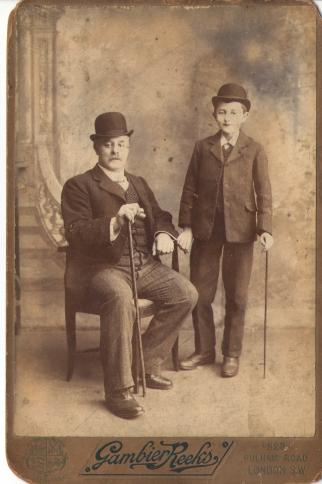
|
Frederick John Martin (Joan's grandfather) was born in Brighton about 1858
and died in Fulham about September 1929. He married Mary Theresa Ennis in
Fulham about December 1892. In the 1901 Census they are shown at 9
Britannia Road, Fulham (which is north of the gas works) and his occupation
is Foreman House Painter (worker as distinct from employer).
John May Martin (Joan's father) was born in Fulham in 1897. I believe this photograph is of Frederick and John. If John is about eight in the photograph, that would date it about 1905. This date is consistent with the date range calculated for the card Ron Cosens' Dating Wizard. Gambier [Curtis] Reeks was born in Evesham, Worcester about 1864. In 1881 he was living in Evesham, the son of Robert [Arthur] Reeks, photographer (born 1840, died Evesham Spring 1925), listed as a photographer in Evesham in 1871 and in 1901. He was working as a photographer on his own account from his home address at 529 Fulham Road in 1901. ("Sambier Reeks"). In 1891 ("Gambeir Reeks") he had been a coachman groom to a Pork Butcher in Camberwell. Gambier married Rachel Woodnut (born Bermondsey 1872) in Camberwell in the late summer of 1895. He died on 28.12.1917 at St George's Infirmary, Fulham Road. Administration London, 28.2.1918 to Rachel Reeks widow. Effects £738.16s.9d Ron Cosens states that Gambier Reeks advertised between 1900 and 1922. Gambier M. [Morgan] Reeks of 529 Fulham Road is listed as a Photographic Artist in a 1921 Directory. PhotoLondon lists Rachel Reeks as the photographer who ran the studio (1917-1921) in her husband's name after his death and died in Uxbridge 1926.
|
In 1939, sons: Frederic Reeks (a butcher's assistant in 1911) of Lewisham, born 4.10.1897 was a Wireless Service Engineer and Gambier M. Reeks, born 28.2.1905, of 45 Brittania Raod, Fulham, was an incapactitated automotive electrician.
Joan's autobiography says the picture of a sweetshop in Sheepcote Lane (below) was painted by her grandfather, Frederick John Martin. However, she suggested to me that it might be by her great- grandfather. On the back of the frame she wrote "Sheepcote Lane. By John Martin. c 1840"
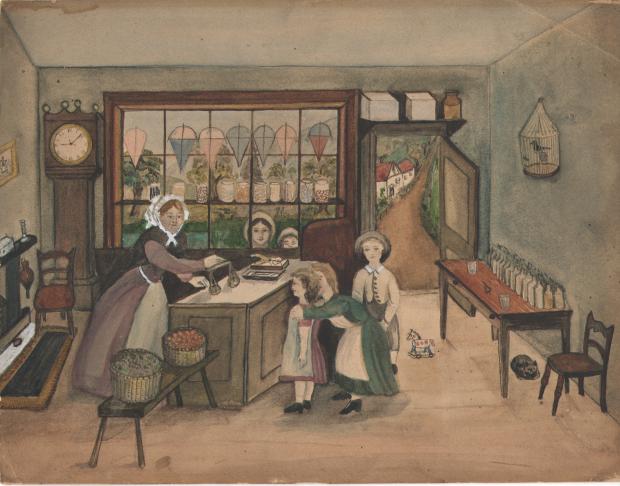
|
In time my father was apprenticed to the same trade. In time he also became foreman, and then changed jobs quite frequently, usually retaining a foreman's position. My father did not inherit grandfather's brittle legs, fortunately; as during the inter-war years, a time of economic depression, his job would certainly not have been safe. As it was, during the ninety-thirties, my mother was often deeply worried, when he was "off work". Sometimes, he had given up his job of his own accord, and at these times, my mother became particularly angry with him. I did not know why he was in and out of work so often, apart from the fact that interior decorating, papering and painting, in which my father specialised, was an erratic job. When one house was finished, there was never any certainty of a new start.
My father was ambitious, and very interested in engineering, to which he had been introduced, while attached to the big guns such as "Big Bertha" in the first world war. He would have preferred this trade to the building trade. But during the ninety-thirties, it was impossible for a working man to change trades. Among his papers, I found a sheet of headed notepaper, giving his name and address, John Martin, 59 May Street, West Kensington, London, W.14 and the designation "Builder and Decorator"; so presumably, he may have tried to set up in business on his own account, but nothing ever materialised from this. However, by 1938, the great depression was coming to a close. The upper classes, certainly, were continuing to have extensive interior decorations. At this time, my father got a job with "Harrod's" , and our family situation financially improved. He later told me that he was continuously employed decorating the "gentry's" houses, including for example, the author, Rebecca West. His best friend was Ted Gardiner, who drank a lot. My mother did not like him for that reason. My baptismal certificate shows Ted Gardiner as Godfather, so he was a Catholic, like so many in the building trade in those days. Many were Irish or descended from a previous wave of Irish immigrants.
One of my passions was collecting cigarette cards. By 1939 when I was eleven I had a box of about 2000, which in a gesture of generosity, I gave to my cousin, Leonard.
EARLIEST MEMORIES
My mother filled up a bath with boiling water which she had carried upstairs to the back room used as sitting room and playroom, in which I passed much of my preschool days. I could see the steam rising from it. She went downstairs to the cold water tap in the "scullery" downstairs. This room adjoined the "kitchen" in which we took breakfast. But I think the scullery in the early 1930's was our only source of water.
Before she left the room she told me to be careful. I was kneeling on a chair next to the bath and gently rocking to and fro. However, I thought I was a clever girl and wanted to rock back and forth as far as I could without falling over. Suddenly there was a splash and I remembered no more until I woke up in the local hospital, my right arm swathed in bandages, which I believe were impregnated with some brown-coloured ointment. My head was also bandaged.
What happened was that I had fallen into that bath of near boiling water and had been seriously scalded. It was lucky that my mother had treated me correctly afterwards, so that I sustained no serious injury. But I was badly frightened and cried when both my mother and father, who were standing by the bed, said "Good-bye". They were leaving me in hospital for the night.
Next day, I came home, but visited the hospital regularly during the next few weeks, to have my arm treated. The scald on my head was trivial. I feared hospitals, and the smell of disinfectant used extensively in the corridors used to send cold shivers down my spine. At Christmastime, I was taken back to the hospital for a children's party. All the children who had been treated during the year were invited, and given a present from the Christmas tree. Then I said, "Perhaps, hospitals aren't so bad, after all."
After this accident, I became more nervous of people, especially of adults, such as schoolteachers. I was particularly frightened of doctors, even of a routine school medical examination.
At the time of the scald, I don't think I had yet started school, but soon afterwards, my first day arrived. This was supposed to be February 25th, 1933, my fifth birthday, but I cried and made a fuss, so much that my mother relented, and agreed to let me have one more week at home. The law, apparently, in 1933 required attendance from the actual day of one's fifth birthday, so that new children were arriving in school continuously, in ones and twos, in the first infant's class. Accordingly, one Monday, near enough to March 6th 1933, my mother took me to school on my first day, as far as the classroom door. I cried. There were numbers or letters suspended on placards from the schoolroom ceiling and these seemed to be shaking about. My mother left me in the room. When I stopped crying, the teacher gave me a "sand tray". Like the other children, I had to draw letters in the sand, but on this first day, my finger was guided, by a strange adult's hand, who was that dragon, the schoolteacher.
I would not remember, at the age of 64, whether it was my left or right arm which had been scalded if I did not still bear the scar, which measures five inches in length; at its extremities is half an inch, and in the middle, one and a half inches. Fortunately the scar on my forehead is barely visible, a small circle of diameter one quarter of an inch.
I have always enjoyed taking measurements. We had a cheap alcohol thermometer, intended to take the temperature of the room. I used to place this as near to the open fire as possible, standing it upright on one side of the hearth. At the moment when the red-dyed liquid had almost expanded to reach the top of the scale, I snatched it away, content with my "experiment". I suppose I was about eight years old, when I did this once too often, and the thermometer was broken. I cried and cried in fear of my father's anger. But on this occasion he was in a good mood and said very little. Mother comforted my tears, and Dad said it indicated my interest in science and bought me a copy of the annual "Pears' Encyclopaedia". This was a book intended for adults, but I read it from cover to cover.
Of particular interest was the entry on "the atom", and though I understood it only vaguely, I followed the references to the electron and to the proton, and read a short account of Rutherford's experiments. Rutherford had split the atom in 1918 in a small-scale "sealing wax and string" experiment in a British University. I think the early editions of "Pears" gave his work prominence over the Curies, Bohr, Max Planck and other early physicists who were studying the structure of matter, because he was British. But most importantly Rutherford was in 1910 one of the first to propose that the atom consisted of a central "nucleus", positively charged and an outer circle of negatively charged electrons. Of course, in 1938 when I was ten years old, I could not have put this clearly, but in a vague way understood that the atom contained energy which could be released, as I then thought to benefit people, and even to demonstrate the wonderful mysteries of God, the Creator.
At the age of ten, my ideas about God were vague, for I had never attended Church or Sunday School. However, my father taught me to say simple prayers at night. He was a lapsed Catholic, but I well remember him saying when I wanted to stop saying "God bless Nana" after his mother had died in 1936, that I should go on praying for her, in addition to praying for all my friends and relations who were alive. This was his Catholic influence, for Catholics have always believed in the special importance of praying for the dead. But at this time I learnt little about religion, beyond the prayers in morning assembly at a State School, and the occasional instruction by my parents. My mother had been brought up in the Church of England, of which my maternal grandmother was a devout member. On holidays with her in the country, I was taken, protestingly to Church of England's "Morning Prayer" on Sundays, a long service with four hymns and two psalms. I always counted the time to the end of the service by means of the number of hymns which had been sung. At the service I noticed little else, and especially not the sermons of Rev. Madeley.
|
|
|

